Alhambra (Granada, Spain)
Kelly Bryant, Danielle Becktel, and Grace Armstrong
Click here to take a virtual walking tour of the Alhambra!
History تاريخ
The framework of the Alhambra can be historically dated to documents from the ninth century, after Muslims had taken over most of Spain in 711. Originally a fortress, it became headquarters for the Nasrid Dynasty-the last Muslim kingdom to rule Spain-in the thirteenth century. It was a high point in Granada, and the royal city of Alhambra was being built during this time period. The placement was chosen at first as a military fortress, as it had a view over the entire city and was at a key offensive and defensive advantage. In 1942, the royal city of Alhambra was conquered by King Ferdinand and Queen Isabella, marking the end of Islam rule for Southern Europe and Spain.1

Plan of the Alhambra from Encyclopedia Britannica 1911 (public domain)
Layout تصميم
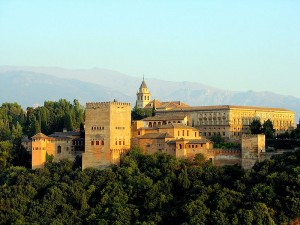
View of the Alhambra
by Bernjan, used under 
The Alhambra is a walled-off royal city inside of Granada. Originally, it was a fortress called the “Red Fort” (the meaning of al-hamra), although the fort itself does not exist today.2 There are many palaces, buildings, fountains, and towers that make up the city and still stand. There are four gates into the Alhambra and three major parts inside the Alhambra: The Alcazaba, The Royal Palaces, and The Generalife, each one with respective sub-parts. The oldest part of Alhambra is the palace complex, built by the Nasrids around the thirteenth century. The Generalife, a summer palace, was most likely built around the beginning of Nasrid rule as well. Around the beginning of the fourteenth century, Muhammad III built the Medina, or the center of the city. During the European Renaissance in the sixteenth century, the Palace of Charles V was erected, and in 1576 the Friday Mosque was replaced with a church. There are a few prayer rooms: a small one in the Sala de la Barca-the sultan’s sitting room and bedroom, a larger one in the Mexuar that overlooks countryside, and a small one in a pavillion in the Partal gardens for the sultan.
Royal Palaces
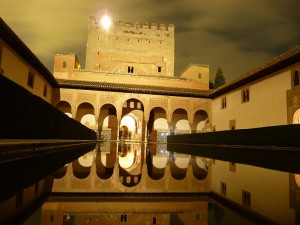
Comares Tower
by JunCTionS, used under 
- The Comares Palace dates back to the 14th century. Catholic monarchs also added palaces,which are said to be the “New Royal Palaces” as compared to the original “Old Royal Palaces.”2 The Comares Palace was used as the official residence of the king.
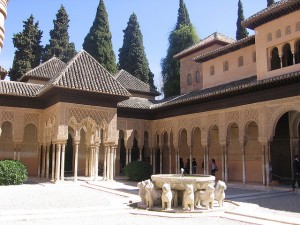
Palace of the Lions
by Gyrus, used under 
- The Palace of the Lions, also dating back to the 14th century, is Mohammed V’s great work of art with beautiful decor utilizing light, water, and colors.3 It surrounds the Court of Myrtles. The rooms have galleries such as the Sala de la Barca and Salon de los Embajadores.1 It contained
the private chambers of the royal family. Nasrid art achieved its greatest degree of magnificence in this palace.3 - The Comares Tower is the tallest tower of the Alhambra and houses the Alhambra’s first throne room, Sala del Mexuar, where important decisions for the kingdom were made. It was used as a chapel after the Christian takeover.
- Wine Gate- It is supposed to be one of the oldest constructions of the Alhambra, and could date from the period of Muhammad II. The exterior facade of the gate is the oldest part, and has a pointed horseshoe arch and embossed voussoirs.3
- The Tower of the Judge, what it was called until the 16th century, and after that called The Tower of the Passing She-Fox, shows that as different people inhabited the Alhambra, names changed, buildings were restored, or torn down.
- The Medina is the town within the palace walls set up to supply and maintain the palace. It had public baths, a mosque, and stores, as well as the sultans’ mausoleum. It also had cisterns and city squares. In the Medina, there were two towers: Tower of the Captives and Tower of the Infants.
Generalife

Generalife
by Antonio Cantero , used under 
- The Generalife was used as a place for leisure and escape from the official duties of the palace.
- It is said to be outside the city walls and separate from the Alhambra.
- It is formed by two groups of buildings that are connected by the Patio of the Irrigation Ditch, which is the most important part of the Generalife because it provides irrigation to the gardens.1
- It is not decorated like the rest of the buildings so as to create a relaxing atmosphere.
- The Generalife also contains the Patio of Cypresses which is known for the majestic staircases.
Alcazaba
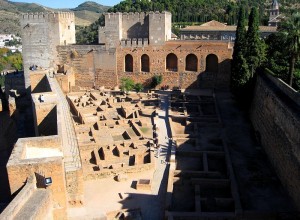
Alcazaba
by Roberto Chamoso G, used under 
- It resembles a small town within the royal city and was where the soldiers and guards of the Alhambra stayed.
- There was a steam bath, a cistern to ensure water supply, and a communal kitchen.
- There were dungeons where prisoners were kept overnight after being worked as agricultural or manual laborers throughout the day.2
- The Guard Tower and the largest tower of the Alhambra, the Tribute Tower, are both part of the Alcazaba. The Guard Tower provides a view of almost all of Granada and also houses the bell. The bell was used to communicate a signal to the farmers for when to water the fields at night and also as a danger warning for Granada. The Tribute Tower most likely had connection to the defense of the city, as it had windows and views to watch towers and fortresses in the mountains surrounding Granada.2
Art فن

Tiling in the Alhambra
by D. M. Harvey, used under 
The architecture and art of the Alhambra is very unique and intricate. The architectural goal was to cover every
space with decoration and is one of the best examples of Islamic art and culture that exists today. While buildings were added over many centuries, much of the art and decoration can be traced back to the time of Muhammed V. Throughout the premises, art can be found in the form of lighting, woodworkd, color, stucco panels,inscriptions, carvings, gardens, fountains, animal representations, wall hangings carpets, arches and pillars. Water is also a key artistic concept which is found as fountains, stone troughs, or small basins known as alberca. During construction, the Nasrids often arranged buildings to surround an inner courtyard with a water source at the middle. Mosaic tiles were also a popular artistic addition to many of the walls of the Alhambra. A main goal of the artistic design and architecture was to enhance every sense of the body.
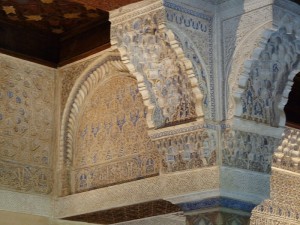
Intricate Pillar in the Sala del Mexuar
by Michael Clarke, used under 
- The Sala del Mexuar’s decoration expresses power and supremacy in the throne room, where decisions were made.
- Colored tile panels line the courts and halls. Tapestries and wall carpets are also utilized.
- The facade has ornamental foliage, inscriptions, and geometry carved into the stucco panels. The glowing colors signified the character of the time when it was built- a high point of building decoration.
- Slender marble columns with delicate capitals are evident. There are 124 white marble columns that support the gallery at the Patio of the Lions.2 Galleries usually have a lintel at the center.
- There are arches at nearly every entrance and exit of each room, hall, tower, or building. Above the arches are stucco panels carved with ornamentation.2
- Each of the halls is decorated with a coat of arms and royal emblems of the royalties that lived there or built that area of the Alhambra.
- The Throne Room is said to include all Nasrid art and architecture of the 14th century.2 Each side of the outer walls of the throne room, except the entrance wall, has an alcove, and the one directly opposite the entrance wall is different and said to be reserved for the sultan. The dado, or pedestal, has mosaic (alicatado) geometric decoration and stucco panels. There are foliage motifs and inscriptions in straight and rounded versions. The roof is covered in many wooden polygon shapes that come together to form stars. The roof also represents the eight heavens of Muslim Paradise.2
- The Palace of the Lions is decorated in a more Christian way than the Comares Palace, which has a significant Muslim influence.1 The fountain of the Palace of the Lions has twelve marble lions surrounding the bowl of the fountain, alternately male and female, which represent power, courage, strength, and justice. This links two points of reference: animals and water.
- There are areas of roof that have wooden latticework inlaid with colored glass, such as in the Hall of the Two Sisters.
- Poetry and scriptures from the Koran are carved into woodwork or stucco panels. “Only God is Victor” can be found in many places including archways, halls, towers, and the throne room. The border surrounding the Patio of the Lions has a poem ascribed on it.
Water ماء

Water: A Means of Life
by DavidInc, used under 
Water was a very important integration into the Alhambra’s decoration but was also important in sustaining life in the city. Water was brought by irrigation and many different water ways to the Alhambra to provide water for drinking, crops, and the fountains that can be seen throughout the premises. The Sultan’s Canal brings water to the Generalife from the Darro River, which is then transported by aqueduct to the city.3As an Islamic palace, there were also baths used for washing. They are not as decorative as other areas but one does have a fountain and tile work. One of the most famous places of the Alhambra is the fountain on the Patio of the Lions. The water provided a soothing sight and the fountains provided a calming sound as well.
Legends of the Alhambra أساطير من قصر الحمراء
- One legend states that the main bath has an opening to the first floor where the king would overlook his wives getting undressed and throw an apple to the one he wanted to stay the night with him.1
- At the Justice Tower, one of the main entrances to the Alhambra, the first horseshoe arch has a hand set into it and the second has a key with a scripture. The hand is said to be either a charm against evil or the fingers represent the five pillars of Islam. The key and scripture is said to represent the power given to Mohammed to open and close the gates of heaven.1 Another legend says that Granada would not fall until the key was grasped by the hand.3
- The Comares Tower is supposedly where the council surrendered the city of Granada to the Catholic monarchs. Legend also says that inside this tower is where Christopher Columbus convinced the Catholic monarchs to support his expeditions and Queen Isabella offered her jewelry to sponsor the expedition.2
- Tradition says that any woman that strikes the bell in the Watch Tower on January 2 (the one day each year that it is struck to remember the date that Granada was surrendered to the Catholic monarchs) will be married before the end of that year.1
- The Hall of the Abencerrajes was notorious as a scene for the massacre of the Abencerraje family whose leader was courting Zoraya, the king’s favorite, the results of which eventually led to the downfall of Granada. The oxidized smears in the fountain are said to be blood stains still visible from the severed heads of the victims that were piled in the basin.4
The Alhambra is primarily used today as a tourist attraction, allowing visitors a sight into its authentic past. The importance of religion and water to the Alhambra are still evident today. From its roots in a time of war to a time of glory, the majestic aura of the Alhambra cannot be mistaken. This mystical ambiance could not even be destroyed through restoration and reconstruction due to improper care over centuries. While the outside appears common and plain, the inside is riddled with mystery through its implementation of art, architecture, and water. It is a site to remember and celebrates Muslim and Moorish history while also offering a breathtaking view.

Alhambra at Night
by Unknown, used under 
December 2013
References
2. Lopez, Jesus B. (2013, March 17). The Alhambra. Islamic Arts & Architecture. Retrieved November 29, 2013, from http://islamic-arts.org/2013/the-alhambra/#top
3. (2009, July 6). Entering the Alhambra. Spain Then and Now. Retrieved December 2, 2013 from http://www.spainthenandnow.com/spanish-architecture/entering-the-alhambra/default_118.aspx
4. (2009, July 6). Alhambra: Court of the Lions. Spain Then and Now. Retrieved December 2, 2013 from http://www.spainthenandnow.com/spanish-architecture/alhambra-court-of-the-lions/default_120.aspx